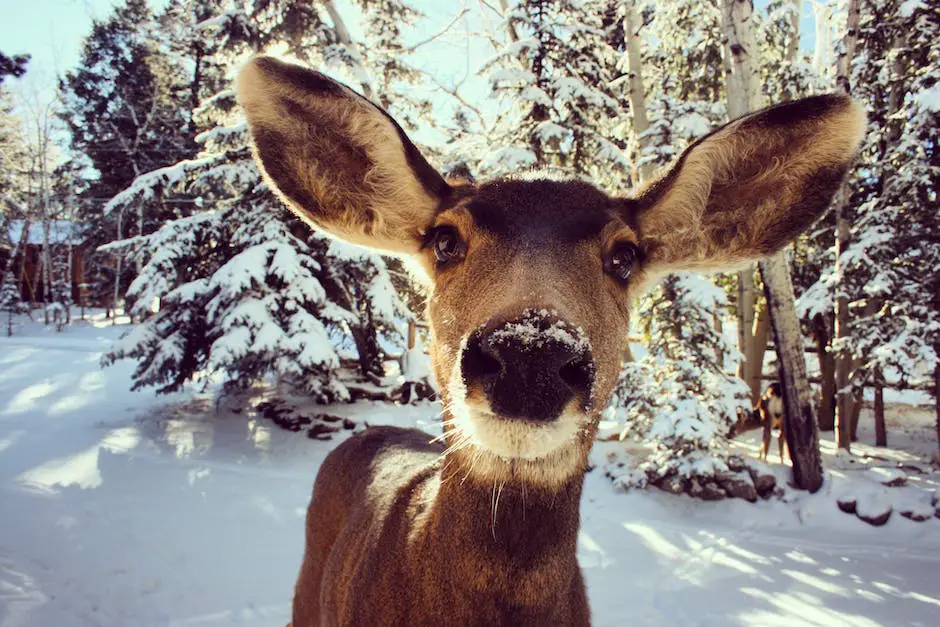Pine trees are evergreen trees that are part of the genus Pinus. There are around 115 species of pine trees, which are native to many different regions around the world. Pine trees typically have needle-like leaves and produce cones.
While pine trees are not typically deer resistant, there are some species that are more resistant to deer than others. For example, the Scots pine (Pinus sylvestris) is a pine tree that is less attractive to deer and is therefore more resistant.
Pine trees are not expressly deer resistant, however, their needles are generally not as palatable to deer as other types of foliage. In addition, the dense growth habit of most pine trees makes it difficult for deer to reach the needles, deterring them from feeding on the trees.
Will deer eat my pine trees?
Although deer will eat pine if they have to, it is not their preferred food. Deer prefer to eat leaves, grass, and other vegetation. If deer are eating pine, it is usually because they can’t find anything else to eat or because the pine is native to their location.
There are a variety of deer resistant conifers and evergreens that can be planted to help deter deer from entering your property. Some of these include the Golden Spreader Nordmann Fir, Monkey Puzzle Tree, Korean Gold Japanese Plum Yew, and Blue Weeping Alaskan Cypress. These plants are all relatively deer resistant and can help to keep your property deer free.
How do I keep deer from eating my pine trees
One of the best ways to protect your plants from deer is to install physical barriers around them. Nylon netting or burlap can be wrapped around the base of the plant, and the edges can be secured with twine or zip-ties. This will create a physical barrier that deer will not be able to penetrate.
There are a number of trees and shrubs that are relatively resistant to deer damage. Some of these include bald cypress, bayberry, cinquefoil, false cypress, forsythia, fringe tree, spirea, and spruce.
What is a deer’s favorite tree?
Oaks are an important part of the whitetail ecosystem, providing food and shelter for these animals. There are many different types of oaks, each of which provides different benefits to whitetails. Red oak seedlings are a favorite browse for deer, while white oak acorns provide a favored mast crop. These trees are essential to the survival of whitetails in many areas, and are revered by hunters and wildlife enthusiasts alike.
Thickets are usually found in woods that are dominated by large pine trees. They offer a lot of protection and coverage for deer, who love to eat the abundant vegetation found there (berries, pine needles, leaves, etc.).
What is the most deer resistant evergreen?
While no plant is ever entirely safe from deer, the following selections usually escape damage in all but the leanest of times:
– Common boxwood (Buxus sempervirens)
– Japanese pieris (Pieris japonica)
– Mountain laurel (Kalmia latifolia)
– Eastern red cedar (Juniperus virginiana)
– Chinese juniper (Juniperus chinensis)
If you’re looking for deer-resistant evergreen trees for your property, consider the eastern red cedar, the Norway spruce, or the deodar cedar. Eastern red cedar trees are tall evergreens with gray-blue fruit and silvery bark, while Norway spruce trees are pyramid-shaped with cascading branches of dark green needles. Deodar cedar trees are perfect privacy-screen trees with greenish-silver foliage. All three of these trees are resistant to deer damage, so you can rest assured that your landscaping will remain intact.
What is the most deer resistant plant
Daffodils, foxgloves, and poppies are common flowers that deer avoid because they are toxic. Deer also tend to turn their noses up at fragrant plants with strong scents. Herbs such as sages, ornamental salvias, and lavender, as well as flowers like peonies and bearded irises, are just “stinky” to deer.
Dear,
Pine damage caused by deer is a consistent problem for many farmers and gardeners. Deer love to nibble on young and tender foliage of thousands of trees and plants. Still, deer prefer some more than others, and White pine is also one of most desirable at the early stage. Therefore, take extra care of your pines and look out for deer damage.
What eats off a pine tree?
Pine weevil pests can cause big problems for pine forests. If left unchecked, these pests can kill entire trees, and sometimes even stunt the growth of healthy trees nearby. Some of the most common pine weevil pests include the pales weevil, the northern pine weevil, and the pine root collar weevil. Pales and northern pine weevil can also attack pine seedlings, making it difficult to replant areas where pines have been recently killed.
Evergreen trees are an important part of the ecosystem as they provide food for many types of animals. Chipmunks and squirrels enjoy the seeds of pinecones, while deer and black bears sometimes stumbled upon a tree and snack on the bark. Some species of woodpeckers also live on these trees, as they are able to find larvae in the soft wood.
What Will deer not walk on
Herbs like lavender, chives, mint, and marigold are all great options for heavily scented plants. These pungent plants work in two ways: Deer will avoid walking through heavily scented plants, as they pick up the smell on their fur and are more noticeable. Furthermore, the scent of these plants can help to mask the smell of other potential food sources, making it less likely that deer will be attracted to your yard in the first place.
Deer tend to prefer browse that is high in protein and low in fiber, such as the tips of twigs and shoots. They will also eat the occasional piece of fruit or acorn. In general, evergreens are a good source of deer browse, as they tend to be high in protein and low in fiber. Maples are also a good choice, as they are high in sugar and calories.
Are there species of trees that deer do not eat?
This tree is also known as the tulip tree, American tulip tree, and yellow poplar. It is a superb shade tree for large yards and is relatively deer resistant.
White pine and Norway spruce are two species of trees that deer find particularly appealing. White pine is more prone to browsing than Norway spruce, but both grow at the same rate. Deer tend to eat the needles of Norway spruce during the late winter months.
What plant attracts deer the most
Perennial clover is a popular food plot planting for deer because it provides attraction during hunting season, high-quality forage during spring and early summer, and several years of food plot production. Clover is a quickly growing crop that can be easily managed with a little planning and preparation.
Deer are attracted to the smell of soil, but if you want to increase the attraction factor, you can pour in some buck or doe urine, or scrape starter into it. This will create an exceptional trail camera site, as bucks will continue to check the scrape every time they pass by or are in the area.
What are deer most afraid of
A radio, activated by a motion detector, can scare off deer. Pie pans, metal cans, or wind chimes suspended by strings make noise when they rattle in the wind, and have also been used to deter damage.
As neophobes, deer are afraid of new, unfamiliar objects. Though they may not always be attractive, scarecrows, sundials, and other garden ornaments can make deer skittish. Use them in combination with wind chimes or bright lights to keep deer out of your yard.
Conclusion
Pine trees are defiantly deer resistant. The biggest herbivores in North America cannot digest the resin in pine needles, which give the tree its characteristic smell.
Although not all types of pine trees are deer resistant, many are. Some of the most deer resistant pine trees include the Eastern White Pine, Northern White Pine, and the Virginia Pine. If you are looking for a deer resistant pine tree for your home, be sure to do your research to find the best type for your area.
Jackson Hill is a passionate arborist with years of experience in the field of trees. He developed his fascination with trees at a young age, spending countless hours exploring the forests and climbing trees. Jackson went on to study arboriculture and horticulture at Michigan State University and later earned a degree in forestry from the University of Michigan.
With his extensive knowledge and expertise, Jackson has become a trusted authority on trees and their impact on the environment. His work has helped shape the field of arboriculture and he continues to be a leading voice in the industry.
